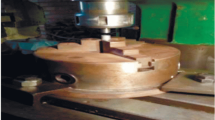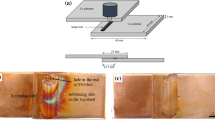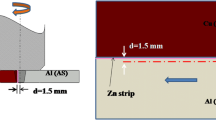Abstract
Rotary friction welding is a means of assembly used in different fields even to perform heterogeneous welds. These latter obtained by conventional techniques in the liquid phase present several difficulties. The fragility of the bead is not only due to the induced metallurgical transformations, but also to the morphology of the interface serving as a physical junction. Then, the hard and brittle intermetallic compounds formed in a non-equilibrium matrix frequently affect the quality and performance of the solder joint. However, the metallurgical bonds obtained by interdiffusion of chemical elements on either side of the interface, in the solid state, often exhibit satisfactory solutions. One of our objectives in the present work consists in attenuating the extent of these undesirable intermetallic compounds, by diluting them in a heterogeneous solution, composed of the two materials to be assembled. It is worth noting that a concentration of stresses may be due not only to a geometric or structural defect, but also to a sudden change of material properties. To avoid such a situation, we propose the technique of inserting a mixture of metallic powders, between the two materials to be joined by rotary friction. This technique consists of going from one material to another in a continuous and progressive way by crossing the powder mixture between them. This allows improvement of certain mechanical and metallurgical characteristics of the solder joint. This technique is implemented and a microstructural and mechanical characterization is carried out on the obtained welded joints between commercial pure copper and carbon steel.





























Similar content being viewed by others
Data availability
The authors confirm that the data supporting the findings of this study are available within the article. The raw data that support the findings of this study are available upon a reasonable request.
Code availability
Finite difference method with the use of the Fortran power station compiler.
Abbreviations
- Cp(i,j):
-
Specific heat to the node (i, j)
- d:
-
Diameter of the parts to be welded
- e:
-
Thickness of the metal powder
- F:
-
Frictional force
- f:
-
Dynamic coefficient of friction
- h:
-
Coefficient of convection
- k(i,j):
-
Thermal conductivity to the node (i,j)
- L:
-
Total length of the two pieces
- L1 :
-
Length of the stationary part
- L2 :
-
Length of the rotating part
- N:
-
Rotation speed
- n:
-
Number of rows of particles
- P:
-
Friction pressure
- Pforg :
-
Forging pressure
- r:
-
Radial position
- rI(i):
-
Positions of interfaces along r
- S:
-
Source term
- T:
-
Temperature
- t:
-
Time
- z:
-
Axial position
- ε:
-
Thickness of a range of particles
- Δt:
-
Time step
- ρ(i,j):
-
Density at the node (i, j)
- i:
-
Increment in radial direction
- j:
-
Increment in axial direction
References
Shiri SG, Nazarzadeh M, Sharifitabar M, Afarani MS (2012) Gas tungsten arc welding of CP-coper to 304 stainless steel using different filler materials. Trans Nonferrous Met Soc China 22:2937–2942. https://doi.org/10.1016/S1003-6326(11)61553-7
Bell RA, Lippold JC, Adolphson DR (1984) An Evaluation of copper-stainless steel inertia friction welds , initial surface condition has a significant effect on weld quality. Weld Res Suppl 325-s–332-s
Kimura M, Kusaka M, Kaizu K, Fuji A (2009) Effect of friction welding condition on joining phenomana and tensile strength of friction welded joint between pure copper and low carbon steel. J Solid Mech Mater Eng 3(2):187–198. https://doi.org/10.1299/jmmp.3.187
Dawson RJC (1983) Welding of copper and copper-base alloys. Weld Res Council Bulletins, WRC Bulletin 287:1–17
Dyja H (1996) Joints of steel-brass one-side welded by explosive method. Acta Phys Pol, A 89(3):411–415. https://doi.org/10.12693/APhysPolA.89.411
Şahin M (2010) Friction welding of différent materials. Unitech, International scientific conference, Gabrovo II-131–134
Meshram SD, Mohandas T, Madhusudhan G, Reddy G (2007) Friction welding of dissimilar pure matals. J Mater Process Technol 184(1–3):330–337. https://doi.org/10.1016/j.jmatprotec.2006.11.123
Kurt A, Uygur I, Paylasan U (2011) Effect of friction welding parameters on mechanical and microstructural properties of dissimilar AISI 1010-ASTM B22 Joints. Weld Res 90(5):102–106
Sahin AZ, Yibas BS, Ahmed M, Nickel J (1998) Analysis of the friction welding process in relation to the welding of copper and steel bars. J Mater Process Technol 82(1–3):127–136. https://doi.org/10.1016/S0924-0136(98)00032-6
Sahin M (2009) Joining of stainless steel and copper materials with friction welding. Ind Lubr Tribol 61(6):319–324. https://doi.org/10.1108/00368790910988435
Fernando C, Ananthapadmanaban D, Sathish R (2011) Experimental observations on friction weldability of copper with steel. International Journal of Applied Engineering Research ISSN 0973–4562 6(20):2349–2355. http://www.ripublication.com/ijaer.htm
Natsume S (1999) Different material welding. Weld Technol 47(6):98–104
Magnabosco I, Ferro P, Bonollo F, Arnberg L (2006) An investigation of fusion zone microstructures in electron beam welding of copper–stainless steel. Mater Sci Eng A 424:163–173. https://doi.org/10.1016/j.msea.2006.03.096
Mai TA, Spowage AC (2004) Characterisation of dissimilar joints in laser welding of steel–Kovar, copper–steel and copper–aluminium. Mater Sci Eng A 374:224–233. https://doi.org/10.1016/j.msea.2004.02.025
Yao C, Xu B, Zhang X, Huang J, Fu J, Wu Y (2009) Interface microstructure and mechanical properties of laser welding copper–steel dissimilar joint. Opt Lasers Eng 47:807–814. https://doi.org/10.1016/j.optlaseng.2009.02.004
Durgutlu A, Gulence B, Findik F (2005) Examination of copper / stainless steel joints formed by explosive welding. Mater Des 26:497–507. https://doi.org/10.1016/j.matdes.2004.07.021
Yilbas BS, Sahin AZ, Kahraman N, Al-Garni AZ (1995) Friction welding of St-Al and Al-Cu materials. J Mater Process Technol 49(3–4):431–443. https://doi.org/10.1016/0924-0136(94)01349-6
Ochi H, Ogawa K, Yamamoto Y, Kawai G, Sawai T (2004) The formation of intermetallic compounds in aluminium alloy to copper friction-welded joints and their effect on joint efficiency. Weld Int 18(7):516–523. https://doi.org/10.1533/wint.2004.3282
Ay I, Çelik S, Çelik I (1999) Comparison of properties of friction and diffusion welded joints made between the pure aluminium and copper bars. BAÜ Fen Bilimleri Enstitüsü Dergisi 1(2):88–102
Imani Y, Besharati Givi MK, Guillot M (2012) Improving friction stir welding between copper and 304L stainless steel. Adv Mater Res 409:263–268. https://doi.org/10.4028/www.scientific.net/AMR.409.263
Abdelsalam AB, Ridwan MM (2012) experimental investigations on friction welding of dissimilar metals. Sudan Eng Soc J 58; No.1
Lee WB, Jung SB (2003) Effect of microstructural variation on the Cu / CK45 carbon steel friction weld joint. Zeitschrift fur Metallkunde, Int J Mater Res Adv Techn 94(12):1300–1306
Wang Y, Luo J, Wang X, Xu X (2013) Interfacial characterization of T3 copper/35CrMnSi steel dissimilar metal joints by inertia radial friction welding. Int J Adv Manuf Technol 68(5–8):1479–1490. https://doi.org/10.1007/s00170-013-4936-7
Jayabharath K, Ashfaq M, Venugopal P, Achar DRG (2007) Investigations on the continuous drive friction welding of sintered powder metallurgical (P/M) steel and wrought copper parts. Mater Sci Eng, A 454–455:114–123. https://doi.org/10.1016/j.msea.2006.11.026
Ochi H, Kawai G, Yamamoto Y, Suga Y (2008) Tensile strength of friction-welded joints of copper alloys to steels . Proceedings of the Eighteenth International Offshore and Polar Engineering Conference Vancouver, BC, Canada, by The International Society of Offshore and Polar Engineers (ISOPE) ISBN 978–1–880653–70–8 (Set); ISBN 1–880653–68–0 (Set)
Shen Z, Chen Y, Haghshenas M, Nguyen T, Galloway J, Gerlich AP (2015) Interfacial microstructure and properties of copper clad steel produced using friction stir welding versus gas metal arc welding. Mater Charact 104:1–9. https://doi.org/10.1016/j.matchar.2015.02.022
Sokolov VI, Blinova AV, Ichev VY (1978) The mechanical properties of brazed joints in the 12KH18N10T steel and between the 12KH18N10T steel and copper M2 in the temperature range 298–4.2 K. Weld Prod 25(4):33–35
Nicholas ED, Jessop T, Dinsdale WO (1978) Friction welding dissimilar metals. Advances in welding processes proceedings, 4th international conference, Harrogate, York, May 1978. Weld Inst 49:23–36
Divagar S.R, Muthu Kumaran M (2015) Joining the different materials using friction welding. A review. Int J Mech Eng Rob Res 4(1):117–122. ISSN 2278–0149 www.ijmerr.com
Kirik I, Balalan Z (2013) Weldability of AISI 304 to copper by friction welding. Mater Test 55(6):442–447. https://doi.org/10.3139/120.110456
Maldonado C, Medina-Flores A, Béjar L, Mejía I (2004) T.H. North, nanoparticle and intermetallic formation in dissimilar friction welds produced with silver interlayers. Cambridge J Microsc Microanal 10(S02):568–569. https://doi.org/10.1017/S1431927604884253
Lee WB, Kim YJ, Jung SB (2004) Effects of copper insert layer on the properties of friction welded joints between TiAl and AISI 4140 structural steel. Intermetallics 12(6):671–678. https://doi.org/10.1016/j.intermet.2004.02.004
Ochi H, Ogawa K (2004) Friction welding using insert metal. Am Weld Soc-weld J 0036:1–6
Sassani F, Neelam JR (1988) Friction welging of incompatibles materials. Weld Res Suppl 265–270-s
Bouarroud E, Bouzidi W, Menchi O, Abdi S (2009) Effects of copper powder insert layer on the properties of friction welded joints between AlCu and AISI 4140 structural steel. Defect Diffusion Forum 283–286:166–170. https://doi.org/10.4028/www.scientific.net/DDF.283-286.166
Aritoshi M, Okita K (2003) Friction welding of dissimilar metals. Weld Int 17(4):271–275. https://doi.org/10.1533/wint.2003.3112
Alves EP, Neto FP, An CY (2010) Welding of AA1050 aluminum with AISI 304 stainless steel by rotary friction welding process. J AerospTechnol Manag, São José dos Campos sep-dec 2010. 2(3):301–306. https://doi.org/10.5028/jatm.2010.02037110
Meshram SD, Mohandas T, Reddy GM (2007) Friction welding of dissimilar pure metals. J Mater Process Technol 184(1–3):330–337. https://doi.org/10.1016/j.jmatprotec.2006.11.123
Kubiszyn I, Pietras A (2003) Numerical modelling of the friction-welding process. Weld Int 17(6):425–430. https://doi.org/10.1533/wint.2003.3136
Lindemann Z, Skalski K, Wlosinski W, Zimmerman J (2006) Thermo-mechanical phenomena in the process of friction welding of corundum ceramics and aluminium. Bull Polish Acad Sci Techn Sci 54(1):1–8
Bouarroudj E, Chikh S, Abdi S, Miroud D (2017) Thermal analysis during a rotational friction welding. Appl Therm Eng 110:1543–1553. https://doi.org/10.1016/j.applthermaleng.2016.09.067
Satyanarayana VV, Reddy GM, Mohandas T (2004) Dissimilar metal friction welding of austenitic–ferritic stainless steels. J Mater Process Technol 160(2):128–137. https://doi.org/10.1016/j.jmatprotec.2004.05.017
Marimuthu S, Balasubramanian KR, Kannan TTM (2021) Mechanical and surface morphology study of Monel – copper joint by rotary friction welding. Mater Today: Proceeding 37:419–424. https://doi.org/10.1016/j.matpr.2020.05.401
Vyas HD, Mehta KP, Badheka V, Doshi B (2021) Friction welding of dissimilar joints copper-stainless steel pipe consist of 0.06 wall thickness to pipe diameter ratio. J Manuf Process 68:1176–1190. https://doi.org/10.1016/j.jmapro.2021.06.050
Author information
Authors and Affiliations
Contributions
El-oualid Bouarroudj: conceptualization, experimental work, data curation, writing the article, software, investigation, reviewing and editing, methodology, analyzing all the obtained raw data and validation.
Said Abdi: supervision, project administration, methodology, validation and involved in the discussion, data curation and writing (original draft preparation), review and editing (final draft).
Djamel Miroud: realization of observations and analyzes on SEM.
Corresponding author
Ethics declarations
Ethics approval
This study complies with the ethical standards set out by Springer. All the authors read and approved the revised manuscript.
Conflict of interest
The authors declare that they have no known competing financial interests or personal relationships that could have appeared to influence the work reported in this paper.
Additional information
Publisher's note
Springer Nature remains neutral with regard to jurisdictional claims in published maps and institutional affiliations.
Rights and permissions
Springer Nature or its licensor (e.g. a society or other partner) holds exclusive rights to this article under a publishing agreement with the author(s) or other rightsholder(s); author self-archiving of the accepted manuscript version of this article is solely governed by the terms of such publishing agreement and applicable law.
About this article
Cite this article
Bouarroudj, Eo., Abdi, S. & Miroud, D. Improved performance of a heterogeneous weld joint of copper-steel AISI 1045 obtained by rotary friction using a metal powder insert. Int J Adv Manuf Technol 124, 1905–1924 (2023). https://doi.org/10.1007/s00170-022-10326-9
Received:
Accepted:
Published:
Issue Date:
DOI: https://doi.org/10.1007/s00170-022-10326-9




